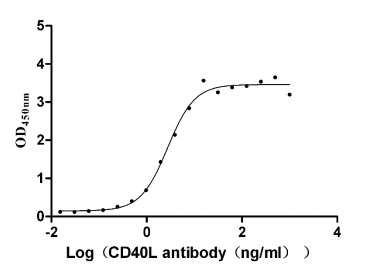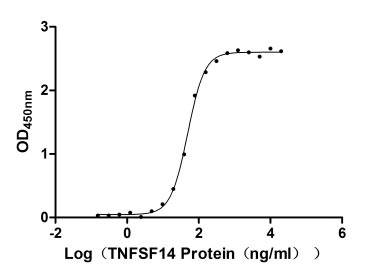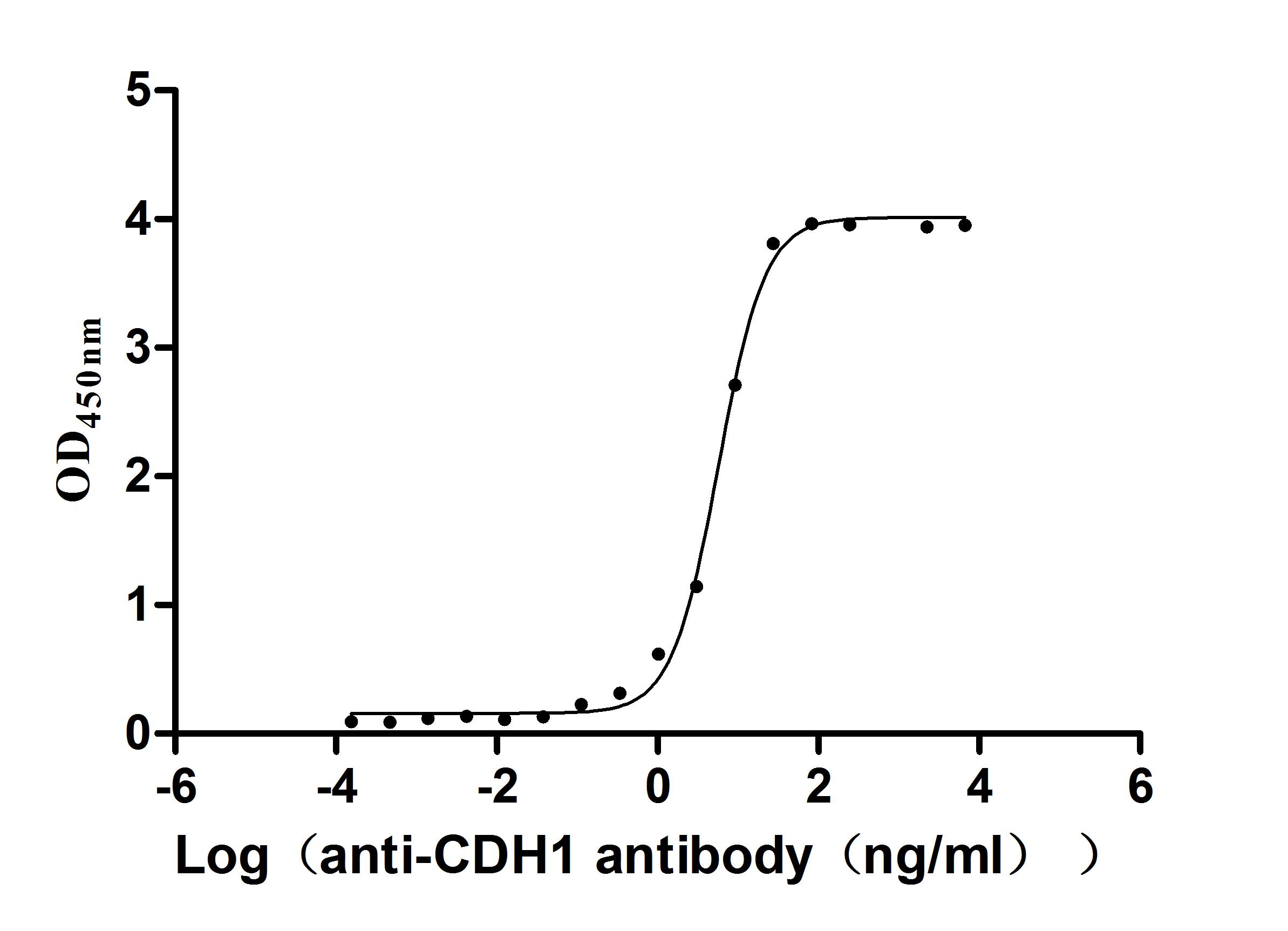Recombinant Mouse C-X-C motif chemokine 14 (Cxcl14)
-
中文名称:Recombinant Mouse C-X-C motif chemokine 14(Cxcl14),Yeast
-
货号:CSB-YP892991MO
-
规格:
-
来源:Yeast
-
其他:
-
中文名称:Recombinant Mouse C-X-C motif chemokine 14(Cxcl14),Yeast
-
货号:CSB-EP892991MO
-
规格:
-
来源:E.coli
-
其他:
-
中文名称:Recombinant Mouse C-X-C motif chemokine 14(Cxcl14),Yeast
-
货号:CSB-EP892991MO-B
-
规格:
-
来源:E.coli
-
共轭:Avi-tag Biotinylated
E. coli biotin ligase (BirA) is highly specific in covalently attaching biotin to the 15 amino acid AviTag peptide. This recombinant protein was biotinylated in vivo by AviTag-BirA technology, which method is BriA catalyzes amide linkage between the biotin and the specific lysine of the AviTag.
-
其他:
-
中文名称:Recombinant Mouse C-X-C motif chemokine 14(Cxcl14),Yeast
-
货号:CSB-BP892991MO
-
规格:
-
来源:Baculovirus
-
其他:
-
中文名称:Recombinant Mouse C-X-C motif chemokine 14(Cxcl14),Yeast
-
货号:CSB-MP892991MO
-
规格:
-
来源:Mammalian cell
-
其他:
产品详情
-
纯度:>85% (SDS-PAGE)
-
基因名:
-
Uniprot No.:
-
别名:Cxcl14; Bmac; Kec; Ks1; Mip2g; Scyb14C-X-C motif chemokine 14; B-cell and monocyte-activating chemokine; Chemokine BRAK; Kidney-expressed chemokine CXC; MIP-2G; Small-inducible cytokine B14
-
种属:Mus musculus (Mouse)
-
蛋白长度:Full Length of Mature Protein
-
表达区域:23-99
-
氨基酸序列SKCKCSRK GPKIRYSDVK KLEMKPKYPH CEEKMVIVTT KSMSRYRGQE HCLHPKLQST KRFIKWYNAW NEKRRVYEE
-
蛋白标签:Tag type will be determined during the manufacturing process.
The tag type will be determined during production process. If you have specified tag type, please tell us and we will develop the specified tag preferentially. -
产品提供形式:Lyophilized powder
Note: We will preferentially ship the format that we have in stock, however, if you have any special requirement for the format, please remark your requirement when placing the order, we will prepare according to your demand. -
复溶:We recommend that this vial be briefly centrifuged prior to opening to bring the contents to the bottom. Please reconstitute protein in deionized sterile water to a concentration of 0.1-1.0 mg/mL.We recommend to add 5-50% of glycerol (final concentration) and aliquot for long-term storage at -20℃/-80℃. Our default final concentration of glycerol is 50%. Customers could use it as reference.
-
储存条件:Store at -20°C/-80°C upon receipt, aliquoting is necessary for mutiple use. Avoid repeated freeze-thaw cycles.
-
保质期:The shelf life is related to many factors, storage state, buffer ingredients, storage temperature and the stability of the protein itself.
Generally, the shelf life of liquid form is 6 months at -20°C/-80°C. The shelf life of lyophilized form is 12 months at -20°C/-80°C. -
货期:Delivery time may differ from different purchasing way or location, please kindly consult your local distributors for specific delivery time.Note: All of our proteins are default shipped with normal blue ice packs, if you request to ship with dry ice, please communicate with us in advance and extra fees will be charged.
-
注意事项:Repeated freezing and thawing is not recommended. Store working aliquots at 4°C for up to one week.
-
Datasheet :Please contact us to get it.
相关产品
靶点详情
-
功能:Chemotactic for CESS B-cells and THP-1 monocytes, but not T-cells.
-
基因功能参考文献:
- Platelets are a relevant source of CXCL14. Platelet-derived CXCL14 at the site of vascular lesions might play an important role in vascular repair/regeneration. PMID: 28359053
- CXCL14 Tg mice showed a suppressed rate of carcinogenesis, decreased tumour volume, and reduced pulmonary metastasis, as well as an increased survival rate of mice following tumour cell injection. PMID: 25765541
- CXCL14 does not seem to play a pivotal role during influenza and Escherichia coli infections of the lung. PMID: 25313607
- CXCL14 was able to promote bone metastasis through enhancement of cancer cell tropism to the bone and/or recruitment of bone marrow cells around metastatic cancer cells. PMID: 24534874
- In conclusion, our results suggested the important function of Cxcl14 in uNK cells and the proper level of Cxcl14 protein were required to recruit NK cells to pregnant uterus. PMID: 23688424
- the transient expression of CXCL14 by Purkinje cells in the developing cerebellum, suggesting that it must be involved in the postnatal maturation of the cerebellum PMID: 22843118
- CXCL14 may play an important role in central nervous system regulation of feeding behavior PMID: 20428232
- Study identifies CXCL14 as a novel marker of tendon connective tissue. PMID: 21038449
- Murine CXCL14 is dispensable for the homeostatic recruitment of antigen-presenting cells toward the periphery and for LC functionality. PMID: 17130243
- CXCL14 is a critical chemoattractant of white adipose tissue macrophages and a novel regulator of glucose metabolism that functions mainly in skeletal muscle. PMID: 17724031
- These results suggest that CXCL14 plays a causal role in high-fat diet-induced obesity. PMID: 17971304
- Data suggest that despite the structural homology and similarity in tissue distribution of human and murine CXCL14, distinct differences point to diverse, species-specific needs for CXCL14 in epithelial immunity. PMID: 18809336
- findings demonstrate that early overexpression of PMP22 in a mouse model of Charcot-Marie-Tooth disease type 1A results in a strong up-regulation of CXCL14 which seems to play a novel regulatory role in Schwann cell differentiation PMID: 19111616
- CXCL14 is an important paracrine/autocrine modulator regulating trophoblast outgrowth at the maternal-fetal interface during the process of pregnancy establishment. PMID: 19626669
- These data indicate the possibility that BRAK expression inhibits tumor cell establishment by regulating interactions between tumor stem cells and NK cells and/or suppressing formation of tumor microvessels. PMID: 19887729
显示更多
收起更多
-
亚细胞定位:Secreted.
-
蛋白家族:Intercrine alpha (chemokine CxC) family
-
组织特异性:Highly expressed in brain, lung, ovary, muscle and in kidney and liver parenchyma, and at lower levels in bone marrow.
-
数据库链接:
KEGG: mmu:57266
STRING: 10090.ENSMUSP00000021970
UniGene: Mm.30211
Most popular with customers
-
Recombinant Human CD40 ligand (CD40LG), partial (Active)
Express system: Mammalian cell
Species: Homo sapiens (Human)
-
Recombinant Human Tumor necrosis factor ligand superfamily member 14 (TNFSF14), partial (Active)
Express system: Mammalian cell
Species: Homo sapiens (Human)
-
Recombinant Human Mucin-17 (MUC17), partial (Active)
Express system: Mammalian cell
Species: Homo sapiens (Human)
-
Recombinant Human Tumor-associated calcium signal transducer 2 (TACSTD2), partial (Active)
Express system: Mammalian cell
Species: Homo sapiens (Human)
-
Recombinant Human Myosin regulatory light polypeptide 9 (MYL9) (Active)
Express system: Yeast
Species: Homo sapiens (Human)
-
Recombinant Mouse CUB domain-containing protein 1 (Cdcp1), partial (Active)
Express system: Mammalian cell
Species: Mus musculus (Mouse)
-
Recombinant Human Transmembrane 4 L6 family member 1(TM4SF1)-VLPs (Active)
Express system: Mammalian cell
Species: Homo sapiens (Human)
-
Recombinant Human Cadherin-1(CDH1),partial (Active)
Express system: Mammalian cell
Species: Homo sapiens (Human)




















